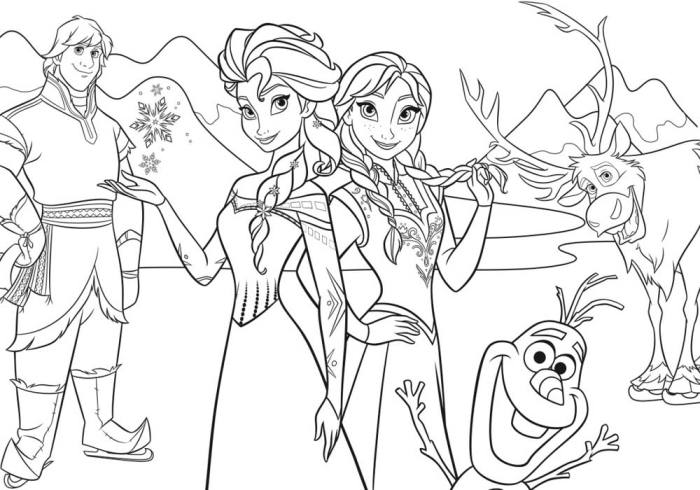
Educational Benefits and Learning Opportunities: Art Coloring Pages For Kids

Art coloring pages for kids – Coloring pages offer a surprisingly rich landscape of educational benefits for children, extending far beyond simple entertainment. They provide a fun and engaging way to develop crucial skills and knowledge, fostering growth in various cognitive and motor areas. This thread explores the significant educational advantages of coloring pages for kids.
Fine Motor Skill Development
Coloring actively engages fine motor skills, crucial for dexterity and hand-eye coordination. The act of holding a crayon or pencil, controlling pressure, and maneuvering within the lines strengthens small muscles in the hands and fingers. This improves precision and control, which are essential for later tasks like writing, drawing, and using utensils. Consistent coloring practice helps refine these skills, leading to improved handwriting and overall manipulative abilities.
Children with underdeveloped fine motor skills often benefit significantly from regular coloring activities.
Creativity and Imagination
Coloring pages are not just about staying within the lines; they’re a canvas for creativity. Choosing colors, experimenting with shading, and adding personal details transforms a simple Artikel into a unique piece of art. This process encourages imaginative thinking and self-expression. Children can interpret the image in their own way, adding their personal touch and storytelling through color choices.
This freedom of expression fosters self-confidence and boosts creative problem-solving skills.
Educational Themes in Coloring Pages
Different coloring page themes can directly support educational goals. Integrating learning into playtime makes the process more enjoyable and effective. Thematic coloring pages can be tailored to teach alphabets, numbers, shapes, and various other concepts. This approach seamlessly blends learning with entertainment, making education more accessible and engaging for young learners.
Examples of Educational Coloring Pages
Coloring pages incorporating educational elements can be incredibly effective learning tools. Here are some examples:
- Alphabet Coloring Pages: Each letter of the alphabet is depicted with a corresponding image (e.g., A for apple, B for ball). This helps children associate letters with objects and sounds, strengthening their phonics skills.
- Number Coloring Pages: Similar to alphabet pages, these feature numbers paired with corresponding quantities of objects (e.g., the number 3 with three balloons). This aids in number recognition and counting.
- Shape Coloring Pages: Various shapes (circles, squares, triangles) are presented, encouraging shape recognition and understanding of geometric concepts. Children can color different shapes in different colors, reinforcing their learning.
- Science-Themed Coloring Pages: These could feature diagrams of the solar system, animals, or plants, helping children learn about scientific concepts in a visual and engaging way. For example, a page showing the different parts of a flower can aid in botany education.
- Historical Figures Coloring Pages: Coloring pages featuring historical figures, such as famous scientists or artists, can spark children’s interest in history and biographies. This approach helps make learning about the past more fun and memorable.
Design and Artistic Elements

Children’s coloring pages offer a diverse range of artistic styles and design elements, catering to different age groups and preferences. Understanding these elements is crucial for creating engaging and stimulating coloring experiences. The choices made in design significantly impact a child’s creative process and the final outcome.
Artistic Styles in Coloring Pages
Coloring pages employ a variety of artistic styles to appeal to children’s diverse tastes. Cartoon styles, characterized by simplified shapes, exaggerated features, and bright colors, are incredibly popular, often featuring beloved characters or whimsical creatures. Realistic styles, while less common in coloring pages designed for younger children, offer opportunities for detailed rendering and shading, suitable for older children with more developed fine motor skills.
Abstract styles, utilizing geometric shapes, patterns, and non-representational forms, encourage experimentation with color and composition, fostering creative expression. These diverse styles cater to a broad spectrum of interests and skill levels.
Color Palettes in Coloring Page Designs
The strategic use of color palettes significantly impacts the overall mood and appeal of a coloring page. Bright, primary color palettes are typically used in cartoon-style pages, creating a vibrant and playful atmosphere. Realistic styles might employ more muted or earth-toned palettes to achieve a sense of realism and depth. Abstract designs can experiment with bolder color combinations, creating high-contrast visuals and stimulating creativity.
The choice of color palette directly influences the child’s creative choices and the overall aesthetic of the finished artwork.
Art coloring pages for kids offer a wonderful way to develop creativity and fine motor skills. A great resource for parents is a comprehensive coloring book for kids , which often includes a wide variety of themes and designs. These books provide a structured approach to art coloring pages, helping children explore different artistic styles and techniques.
Ultimately, art coloring pages, whether from a book or individual sheets, are a valuable tool for children’s development.
Line Weight and Detail in Engaging Coloring Pages
Line weight and detail play a crucial role in creating engaging coloring pages. Thicker lines are easier for younger children to color within, preventing frustration and encouraging participation. More intricate line work, including fine details and textures, presents a challenge for older children, fostering improved fine motor skills and a sense of accomplishment. The balance between simplicity and complexity is key to creating coloring pages that are both accessible and stimulating for a wide range of ages and abilities.
A well-balanced design caters to different skill levels and encourages engagement.
Sample Coloring Page Designs
Design 1: Cartoon Style – A Friendly Dragon
This design features a friendly, cartoon-style dragon with simplified shapes, large eyes, and a playful expression. The line weight is thick and consistent, making it easy for young children to color. The color palette consists of bright, cheerful colors such as greens, blues, and oranges. The design encourages creativity with simple details such as scales and spikes.
Design 2: Realistic Style – A Majestic Lion
This design showcases a majestic lion with detailed fur, expressive eyes, and a realistic pose. The line weight varies to create depth and texture, with thinner lines used for finer details like fur strands. The color palette is more subdued, using earth tones like browns, tans, and golds, with subtle shading to enhance realism. This design is suitable for older children and encourages attention to detail and shading techniques.
Design 3: Abstract Style – Geometric Patterns
This design features interlocking geometric shapes and patterns, creating a visually stimulating and abstract composition. The line weight is consistent throughout, creating a clean and modern look. The color palette is bold and vibrant, using contrasting colors to create visual interest. This design encourages creative exploration of color and pattern, fostering self-expression.
Marketing and Accessibility
Reaching parents and educators with engaging coloring pages requires a multi-pronged marketing strategy that leverages both online and offline channels. Accessibility ensures inclusivity, making the coloring experience enjoyable for all children.Marketing coloring pages effectively involves understanding your target audience and choosing the right platforms to reach them. Accessibility features ensure that children with various disabilities can participate in the creative process.
Offering multiple formats increases the usability and reach of your coloring pages.
Marketing Strategies for Parents and Educators
Effective marketing strategies focus on highlighting the educational benefits and engaging designs of the coloring pages. This includes utilizing social media platforms like Instagram and Facebook to showcase visually appealing examples, partnering with parenting blogs and educational websites for reviews and features, and offering free samples or discounts to attract initial interest. Consider targeted advertising campaigns on platforms frequented by parents and educators, such as those related to homeschooling or early childhood education.
Participating in relevant online and offline events, like teacher conferences or craft fairs, can also be highly effective.
Accessibility for Children with Disabilities
Designing inclusive coloring pages requires careful consideration of various disabilities. For children with visual impairments, using bold lines, high-contrast colors, and tactile elements (if in a physical format) can enhance the experience. For children with motor skill challenges, larger print sizes, thicker lines, and simplified designs can improve usability. Consider providing alternative formats like large-print versions or digital versions with adaptive tools.
Collaborating with disability organizations and seeking feedback from parents of children with disabilities is crucial for ensuring inclusivity.
Distribution Formats and Platforms, Art coloring pages for kids
Offering coloring pages in multiple formats expands their reach and accessibility. Printable PDFs are ideal for immediate use and printing at home or in classrooms. Digital downloads provide flexibility and reduce the environmental impact of printing. Consider offering both options to cater to different preferences.
- Printable PDFs: Easily downloadable and printable, suitable for home and classroom use.
- Digital Downloads: Accessible through online stores or websites, often offering greater flexibility and convenience.
- Subscription Services: Offer a regular stream of new coloring pages, creating a sense of community and ongoing engagement.
- Social Media Platforms: Sharing free samples and promoting new releases via platforms like Instagram and Pinterest.
- Educational Websites and Blogs: Partnering with relevant websites to offer coloring pages as a resource or bonus content.
- Online Marketplaces: Selling coloring pages through platforms like Etsy or Teachers Pay Teachers.
General Inquiries
Are digital coloring pages better than printable ones?
Both offer advantages. Digital pages allow for easy saving, sharing, and color experimentation. Printable pages offer a tactile experience and can be displayed. The best choice depends on individual preferences and access to technology.
How can I make my own coloring pages?
You can create your own using drawing software or even hand-drawn illustrations that are then scanned and digitally enhanced. Many free online resources offer templates and tutorials.
What are some safety tips for using coloring pages with young children?
Supervise young children to prevent them from putting crayons or markers in their mouths. Choose non-toxic crayons and markers. Ensure the coloring area is well-lit and comfortable.
How can I incorporate coloring pages into homeschooling?
Use coloring pages as rewards, incorporate them into themed lessons (e.g., coloring animals while studying habitats), or use them for practicing letter and number recognition.